Visit Our Aquarium
Learn how Rockie's dream of a World-Class Aquarium was brought to life.
About Our Aquarium
A 3,000-gallon aquarium in a dealership showroom? You bet! In fact, our beautiful saltwater aquarium is the focal point in our dealership's showroom and the realization of a dream for owner, Rockie Williams. If you haven't stopped by Rockie Williams Premier in Mt. Juliet, Tennessee to check it out, it's worth the trip!
Rockie wanted a world-class feature to match the grand scale of his state-of-the-art dealership. The custom 13-foot cylindrical tank was thoughtfully conceived and artfully designed by Titan Aquatic Exhibits. It is the largest free-standing saltwater aquarium in the Southeast (outside of an exhibit). Aquarium Artisans strategically installed the fish tank right in the middle of the showroom where our guests can enjoy it every time they visit!
Learn how Rockie's dream was brought to life
Showroom guests are constantly amazed to learn that 1" acrylic is all that stands between them and the 28,000 pounds of water that is home to 16 different types of fish and aquatic creatures.
We rely on local aquarium experts from ZoOceanarium Group to keep it running smoothly with weekly maintenance. The custom-designed aquarium has its own remote filtration system located 80 feet away in a dedicated 12' x 12' aquarium life support room that sustains the ecological balance within the showroom aquarium as well as a 370-gallon tank in the dealership's boardroom.
Kendra, our receptionist, feeds the fish once a day with a specially-selected diet of algae pellets and frozen food preparations.
In addition to snails and a stunning arrangement of fiberglass coral, the aquarium is home to a growing and diverse community of aquatic life - and we're always adding more! The combination of fish is carefully selected to provide a variety of color and swim patterns, as well as favorable cohabitation tendencies.
| Monday | 8:30AM - 7:00PM |
| Tuesday | 8:30AM - 7:00PM |
| Wednesday | 8:30AM - 7:00PM |
| Thursday | 8:30AM - 7:00PM |
| Friday | 8:30AM - 7:00PM |
| Saturday | 8:30AM - 7:00PM |
| Sunday | Closed |
| Monday | 7:00AM - 6:00PM |
| Tuesday | 7:00AM - 6:00PM |
| Wednesday | 7:00AM - 6:00PM |
| Thursday | 7:00AM - 6:00PM |
| Friday | 7:00AM - 6:00PM |
| Saturday | 8:00AM - 3:00PM |
| Sunday | Closed |
| Monday | 7:00AM - 5:30PM |
| Tuesday | 7:00AM - 5:30PM |
| Wednesday | 7:00AM - 5:30PM |
| Thursday | 7:00AM - 5:30PM |
| Friday | 7:00AM - 5:30PM |
| Saturday | 8:00AM - 3:00PM |
| Sunday | Closed |
New Fish Just Arrived!
Here's what we've added recently. Read more about them below.
Emperor Angelfish

Queen Angelfish

Convict Tang

Sunset Wrasse
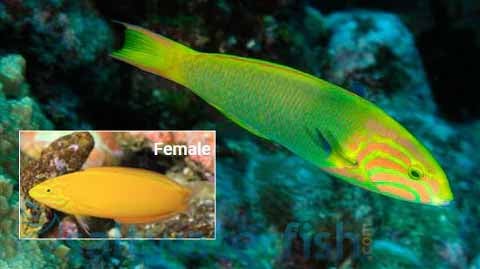
Paddlefin Wrasse
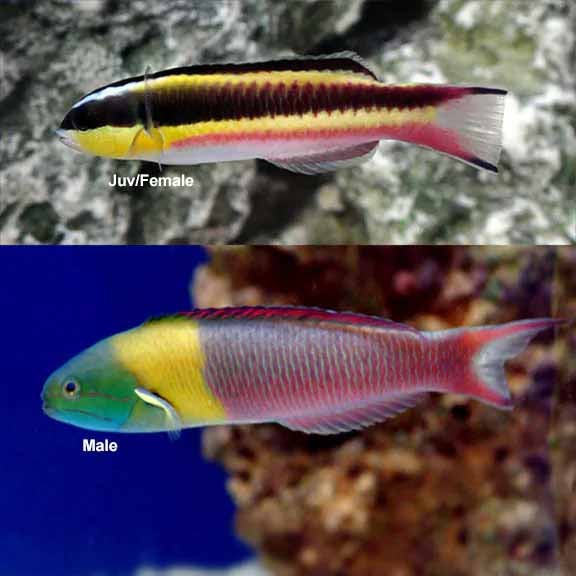
Our Aquarium Residents
Here's a list of the types of fish and aquatic residents currently living in our world-class aquarium. We encourage you to enjoy a few relaxing moments at the fish tank whenever you visit, while we tend to your vehicle needs. And, feel free to pick out a favorite fish.
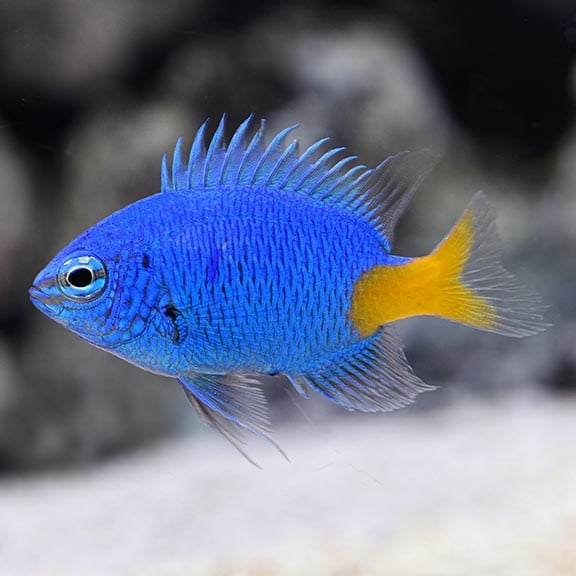
Yellowtail Damselfish
The Yellowtail Damselfish is widely considered to be the ultimate damselfish, partly because of its contrasting jewel-blue body and vibrant yellow tale. This color combination looks stunning against any backdrop of corals and live rock. Extremely hardy, the gorgeous Yellowtail Damsel is less aggressive and does not need as large of an aquarium as other Damsels.
Native to the reefs of the Indo-Pacific, the Yellowtail Damselfish prefers multiple hiding places and peaceful tankmates. Though most Yellowtail Damselfish will ignore other fish, invertebrates, or corals, some may be territorial towards its own kind or similar-sized fish. The Yellowtail Damsel is best kept in small groups of odd numbered fish in suitably sized systems.
Also known as the Yellowtail Blue Damselfish or Yellowtail Demoiselle , the Yellowtail Damselfish feeds on zooplankton and algae in the aquarium. For best care, it should also be fed a varied diet of meaty foods, such as mysis and vitamin-enriched shrimp. It is best to feed several small meals throughout the day.
Yellowtail Damsels have been bred in captivity. Though difficult to sex, males are usually larger and more slender, and become aggressive towards females when ready to mate. However, the male Yellowtail Damsel is ultimately responsible for the care and guardianship of the eggs and will become very territorial while watching over his brood.
Approximate Size: 3/4" to 1-1/2"
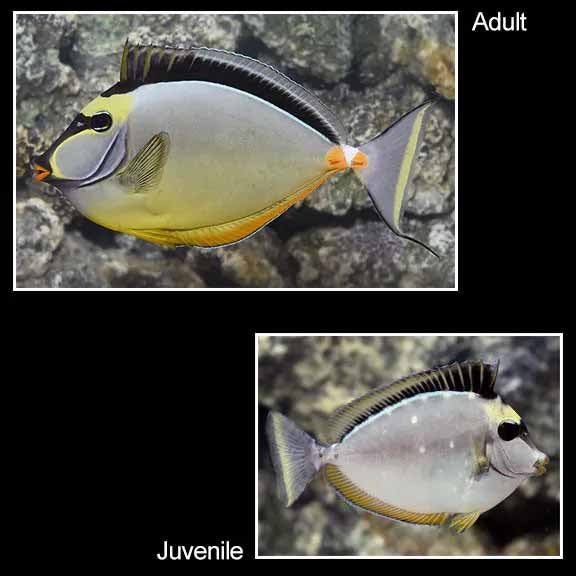
Naso Tang
The Naso Tang, also known as the Orangespine Unicornfish , darkens with maturity. Naso Tangs from Hawaii are often more brightly colored than those found in other areas. As a juvenile, the Naso Tang from Hawaii is dark gray with a blue stripe along the dorsal fin and an orange stripe along the anal fin. The body of a mature Naso Tang changes to a reddish-brown tone and the striping becomes more dominant. The tail takes on a lyre shape with a yellow vertical bar towards the back. Two orange patches appear at the peduncle spines near the tail. However, the most dramatic change is to the face. A thin, black mask, outlined with bright yellow, forms between the eyes and mouth and the lips develop a reddish-orange color.
A 180-gallon or larger aquarium is necessary to provide plenty of swimming room, and places to hide, with a tight-fitting lid provided to prevent jumping to escape. While often aggressive towards other tangs, the Naso Tang is peaceful with other fish in the tank.
Although Tangs will eat meaty foods along with the other fish in the aquarium, it is important that they are offered plenty of marine based seaweed and algae to strengthen their immune system, reduce aggression and improve their overall health. Offer dried seaweed tied to a rock or use a veggie clip, and feed at least 3 times per week. Sea Veggies, Seaweed Salad and Ocean Nutrition are all ideal products and are very easy to use.
Approximate Size: Small: 1" to 2"; Small/Medium: 2" to 3"; Medium: 3" to 4"; Medium/Large: 4" to 6"; Large: 6" to 8"; X Large 8" to 9"
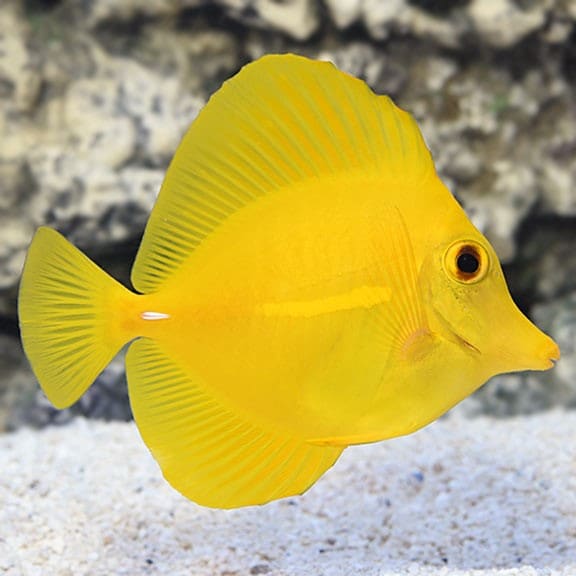
Yellow Tang
An extremely popular and hardy addition to any fish-only or reef aquarium system, the Yellow Hawaiian Tang is often considered the definitive fish of home saltwater aquariums. With its oval-shaped, vibrant yellow body, Zebrasoma flavescens brightens any marine system. The Yellow Hawaiian Tang is an active swimmer and a joy to watch as it remains in near constant motion.
The Yellow Hawaiian Tang's natural habitat spans throughout the Pacific Ocean as far as Indonesia and the Great Barrier Reef, but it has become iconic to the reefs of Hawaii. The Yellow Hawaiian Tang is also known as the Yellow Sailfin Tang or Yellow Surgeonfish . For best care, it should be housed in an aquarium of at least 100 gallons with ample room to swim. Like other Tangs, the Yellow Hawaiian Tang demonstrates territorial aggression towards its own species, or Tangs in general. Therefore, it is best to keep just one Yellow Hawaiian Tang per aquarium, unless multiple Yellow Hawaiian Tangs are introduced into the system simultaneously.
Although the Yellow Hawaiian Tang will eat meaty foods along with the other fish in the aquarium, it is important to offer plenty of marine based seaweed and algae to strengthen its immune system, reduce aggression and improve overall health. Offer dried seaweed tied to a rock or use a veggie clip, and feed at least three times per week. Sea Veggies, Seaweed Salad and Ocean Nutrition are all ideal products and are very easy to use.
Approximate Size: Small: 1-1/2" to 2-1/2"; Small/Medium: 2-1/2" to 3"; Medium: 3" to 3-1/2"; Medium/Large 3-1/2" - 4-1/2"; Large: 4-1/2" to 6"
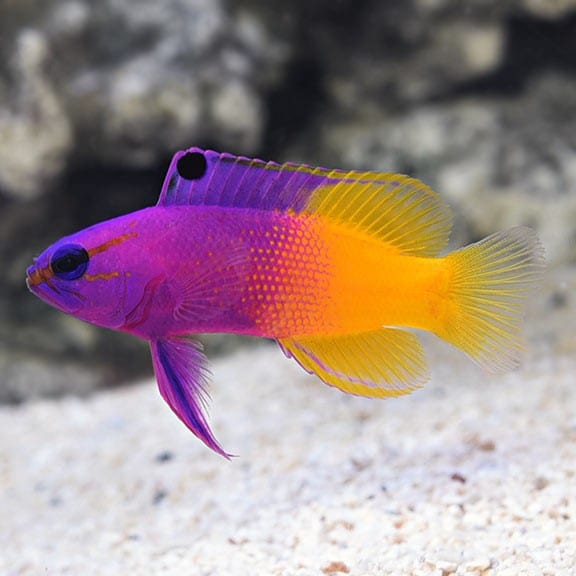
Royal Gramma
The Royal Gramma , also know as the Fairy Basslet , is a colorful addition to any saltwater aquarium. It has a bright purple to violet colored anterior contrasted by a vibrant yellow posterior and is coveted for both its unique color pattern and relatively small adult size. Gramma loreto is well suited for small reef systems of at least 30 gallons.
Native to the deep-water reefs of the Caribbean, the Royal Gramma prefers extensive rockwork caves in which to hide and somewhat subdued lighting. The Royal Gramma Basslet is territorial and aggressive towards its own kind, but generally peaceful towards tankmates of similar size and temperament.
The Royal Gramma is a carnivore, preferring a varied diet of meaty fare, including marine fish, crustacean flesh, mysis shrimp, and quality frozen preparations.
Approximate Size: Small: 3/4" to 1-1/4"; Medium: 1-1/4" to 1-3/4"; Large: 1-3/4" to 2-1/2"
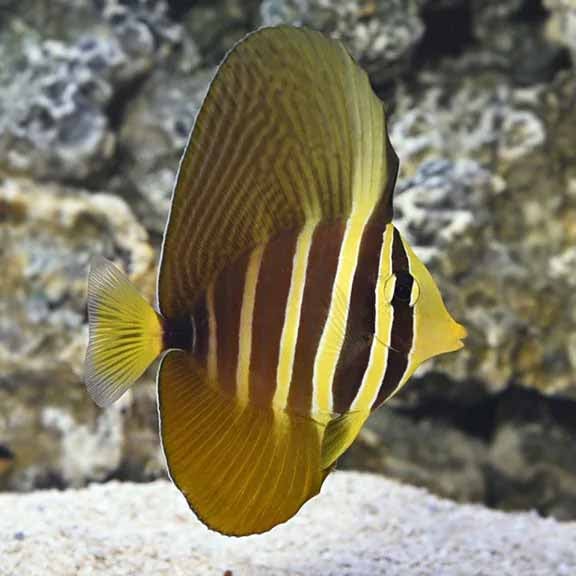
Sailfin Tang
The Sailfin Tang , also known as Pacific Sailfin Tang , has an oval body shape with several rich, distinctive bold markings. Brown with light freckles on the nose, the Sailfin Tang's body has five, vertical yellow stripes with intricate markings within each stripe. Its tail is bright yellow with blue highlights at the tip. The Sailfin Tang can practically double in size at will just by raising or lowering its tall dorsal and anal fins.
A 180-gallon or larger aquarium is necessary to provide plenty of swimming room. It is aggressive towards its own species, but peaceful towards other fish in the tank. It is best to introduce like species at the same time.
Although Tangs will eat meaty foods along with the other fish in the aquarium, it is important that they are offered plenty of marine based seaweed and algae to strengthen their immune system, reduce aggression and improve their overall health. Offer dried seaweed tied to a rock or use a veggie clip, and feed at least 3 times per week. Sea Veggies, Seaweed Salad and Ocean Nutrition are all ideal products and are very easy to use.
Approximate Size: Tiny: 3/4" to 1-1/4"; Small: 1 1/4" to 2"; Small/Medium: 2" to 3"; Medium: 3" to 4"; Medium/Large: 4" to 5"; Large: 5" to 6"
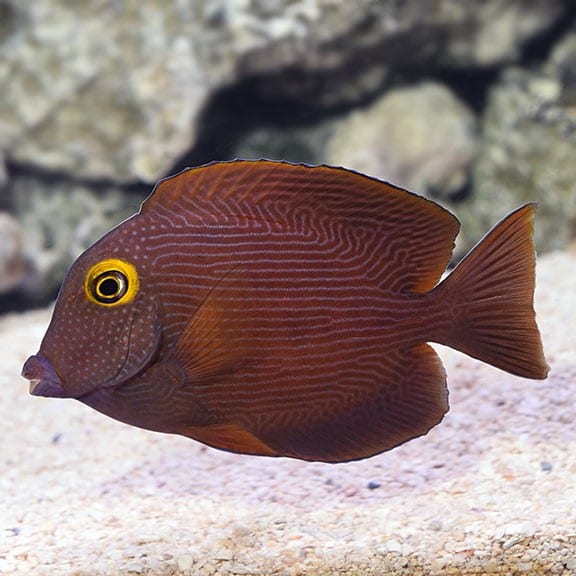
Kole Tang
The Kole Tang is known by many names including Kole Yellow Eye Tang, Yellow Eye Tang, Yellow Eye Surgeonfish, Striped Bristletooth, and Goldenring Bristletooth. It has an oval body shape with bold markings that change as it matures. The young Kole Tang has a yellow-gold to tan colored body with stripes and spots. As it grows, the body color darkens and changes from blue to burgundy. A mature Kole Tang can have a majority of either spots or stripes, depending on what part of the world it is from.
A 70-gallon or larger aquarium is necessary to provide plenty of swimming room. While it will not harm invertebrates, it is best to only keep one Kole Tang per tank they can be aggressive towards other Tangs. Like all other surgeonfish, the Kole Tang also features a scalpel, a sharp spine at the base of its tailfin, which is used for protection and helps in establishing dominance. Take precautions before handling this fish, as this scalpel fin can inflict painful wounds.
Kole Tangs are well-known for their algae eating habits, but will eat meaty foods along with the other fish in the aquarium. Provide them with some live rocks that encourage the growth of natural algae. If algae growth is insufficient, offer plenty of marine based seaweed and algae or algae pellets. This will strengthen their immune system, reduce aggression and improve their overall health. Offer dried seaweed tied to a rock or use a veggie clip, and feed at least 3 times per week. Sea Veggies, Seaweed Salad and Ocean Nutrition are all ideal products and are very easy to use.
It is best to keep many hiding places and spots for them to rest during the night. As with other Tangs, the Kole Tang thrives well in a temperature of 72-78 degrees Fahrenheit, and pH of 8.1-8.4. It is a relatively peaceful fish and housing it with other aggressive fish is a big NO, as it can be eaten or harmed by those aggressive fishes.
Approximate Size: Small: 1-1/2" to 2-1/2"; Small/Medium: 2-1/2" to 3-1/4"; Medium: 3-1/4" to 4-1/4"; Medium/Large: 4-1/4" to 5"; Large: 5" to 6"
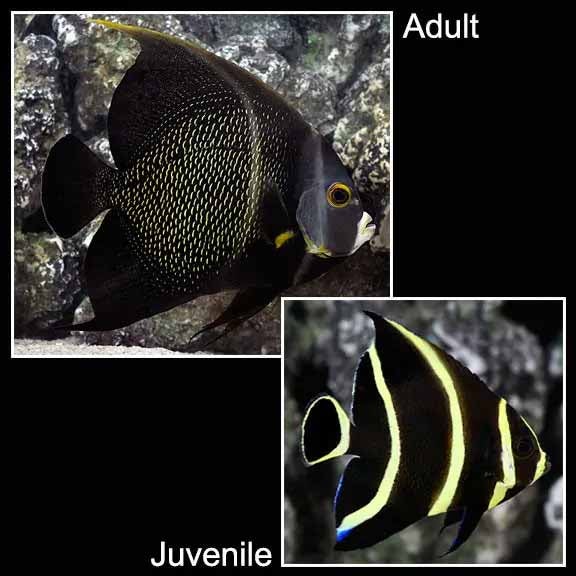
French Angelfish
The French Angelfish is one of the more popular angelfish varieties. As the French Angelfish matures, its coloration changes from stripes to a more dappled appearance. The mature French Angelfish has a pale dusty-blue face and eyes rimmed in yellow and white. The body is dark, dusky-blue with yellow scale margins. A yellow smudge highlights the pectoral fin while the gill cover has a yellow rim.
A 250-gallon or larger tank should be provided and include large amounts of live rock for hiding and grazing. The French Angelfish is not a good candidate for a natural reef tank, as it has a tendency to nip at coral and clam mantles, and also tends to dominate the tank.
The diet of the French Angelfish should include Spirulina, marine algae, occasional high-quality angelfish preparations with added sponge matter, and mysis or frozen shrimp. It should be fed at least three times daily.
Approximate Size: Juvenile Tiny: 1/2" to 1"; Small: 1" to 1 1/2"; Medium: 1 1/2" to 2 1/4"; Large: 2 1/4" to 3 1/4"; Changing: Medium/Large: 4" to 5"; Adult Small: 3" to 3-1/2"; Small/Medium: 3-1/2" to 4"; Medium: 4" to 5"; Medium/Large: 5" to 6"; Large: 6-1/2" to 7"; X Large: 7" to 7-1/2"
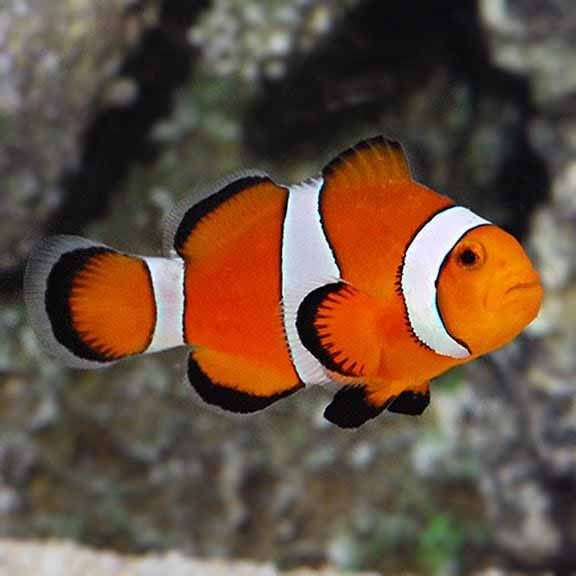
Orange Clownfish
There are nearly 30 species of Clownfish. The Orange Clownfish, also called Percula Clownfish or Clown Anemonefish, is distinguished by its vivid orange color with distinctive white bands outlined in black. This family of fish is also known as anemonefish because of the symbiotic relationship they have with sea anemones. The Clownfish brings food to the anemone and helps keep it clean in exchange for protection. By building a protective coating of mucous, the Clownfish is immune to the stinging cells of the anemone.
Clownfish grow to approximately 3 inches in length and may be one of the aquarium industry's most popular marine fish. The Orange Clownfish is an excellent addition to almost any saltwater aquarium system and often lives in association with sea anemones.
All Clownfish are born male. As they mature, they usually pair off with other Clownfish, and the dominant fish becomes a female. The female Clownfish lays eggs on a flat surface, which are defended and aerated by both parents until they hatch.
In the wild, the Orange Clownfish inhabits coral reefs in Australia, Indonesia, Singapore and the Solomon Islands. Clownfish are omnivores, and aggressive eaters, feeding on variety of algae, zooplankton, worms and small crustaceans. It will accept most meaty foods and frozen herbivore preparations.
Approximate Size: Small: 1/2 - 1"; Medium: 1" to 2"
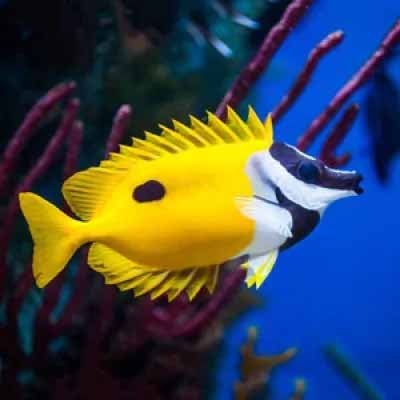
Foxface Fish
The One Spot Foxface Fish, also called Blotched Foxface, is a species of rabbitfish found at reefs and lagoons in the tropical Western Pacific. They have a small, hare-like mouth, large dark eyes and a peaceful temperament, but their venomous dorsal and anal fin spines can inflict a painful sting if handled improperly. The Foxface Fish features a distinct "eyespot" on its body. This dark spot can range from an almost symmetrical circle to a "free-formed" blotch, giving each fish a unique and individual appearance.
The One Spot Foxface Fish thrive in a 70-gallon or larger aquarium. It is a very peaceful species except when housed with other rabbitfish. The One Spot Foxface may co-exist with more aggressive fish since predators and aggressors will tend to leave it alone because of its venomous dorsal spines. Rabbitfish are omnivorous, eating mostly algae and zooplankton. If hungry, it may nip at corals.
The diet of the One Spot Foxface Fish should include fresh vegetables and algae. Provide a variety of prepared herbivore foods rich in vegetable matter and supplement diet with algae sheets to help reduce potential nipping damage to soft and hard coral polyps.
Approximate Size: Small: 1-1/2" - 2"; Small/Medium: 2" to 3"; Medium: 3" to 4"; Medium/Large: 4" to 6"; Large: 6" to 8"
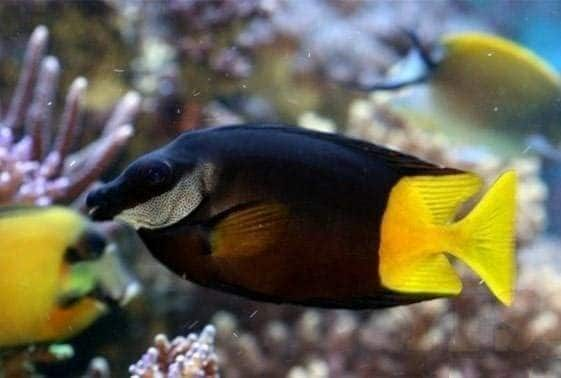
Fiji Foxface Fish
The Fiji Foxface or Bicolor Foxface Fish is one of the most unique rabbitfish and is a bright, attractive addition to any peaceful community tank. The front portion the Fiji Bicolor Foxface's body is a dark, blackish-brown with black and white facial markings, while the back half of the Bicolor Foxface is yellow. The Bicolor Foxface is an active swimmer and requires at least a 100-gallon aquarium. Generally peaceful, the Bicolor Foxface can be housed with aggressive or peaceful fish, but is known to become aggressive when housed with other rabbitfish.
The Fiji Bicolor Foxface is found in shallow lagoons in the Indo-Pacific and eastern Mediterranean. The Fiji Bicolor Foxface raises its venomous dorsal spines when threatened. Typically, the Bicolor Foxface is reef safe, as long as it is well fed, but they have been known to nip at and eat coral. As an herbivore, the Fiji Bicolor Foxface should be offered a variety of algae and fresh vegetables.
Approximate Size: Small: 2" to 3"; Medium: 4" to 5"; Large: 7" to 7"; Large: 6" to 8"
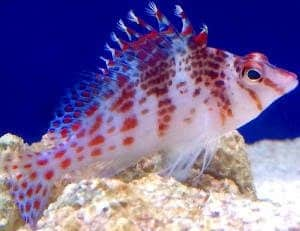
Falco Hawkfish
The Falco Hawkfish is named for its habit of using coral as a perch from which it swoops out and snags its prey. The unique-looking Hawkfish is white with red-brown spots that run diagonally along the body. They have small tufts of bright yellow on the tips of their dorsal fin ray called cirri and are often called Spotted Hawkfish.
Hawkfish are generally considered to be an unsociable fish, due to its aggressive and predatory nature. However, the Falco Hawkfish is a peaceful fish that should be considered as a wonderful addition to any aquarium, but should not be housed with more aggressive Hawkfish.
A 30-gallon or larger aquarium with plenty of hiding places is best. Falco Hawkfish have been known to jump from an aquarium, so it should be kept in a tank with a covered lid.
The Falco Hawkfish diet should include a variety of marine meats, frozen preparations, and live feeder shrimp.
Approximate Size: Small: 3/4" to 1-1/4"; Medium: 1-1/4" to 2"; Large: 2" to 3
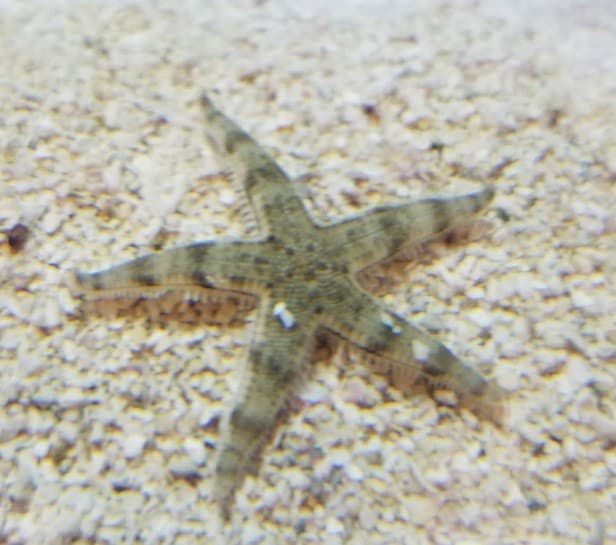
Sand Starfish
When it comes to cleaning the sand bed, the Sand Starfish is unparalleled in its effectiveness. Its thick, spine-covered arms feature alternating bands of brown and beige that allow the starfish to blend in with the sand. Also known as the Comb Starfish , White Starfish and Sand Sifting Starfish , the Sand Starfish works wonders for its constant sifting and cleaning of the sand. It is also one of the most popular starfish for home aquariums.
Nocturnally active, the Sand Starfish efficiently consumes mass amounts of debris and uneaten foods and can move large amounts of sand as it burrows into the substrate in search of food. The Sand Starfish will also consume small invertebrates, including shrimp, urchins, mollusks, bivalves, or other small starfish and should be actively fed a varied diet consisting of natural food sources, especially in well-established marine aquariums. Otherwise, this voracious feeder will quickly clean your aquarium of debris and then burrow into the substrate, starve, and eventually begin to decay.
The Sand Starfish is delicate and must be kept in a tank with a deep sand bottom. They are very intolerant of sudden changes in oxygen levels, salinity and PH and don't tolerate copper-based medications. Since it is slower moving than most fish, the Sand Starfish should not be housed with natural predators, including Puffers.
To successfully acclimate new specimens to your aquarium, use the drip acclimation method and never expose the Sand Starfish to air while handling.
Approximate Size: Small: 1-1/2" to 2-1/2"; Medium: 2-1/2" to 4"
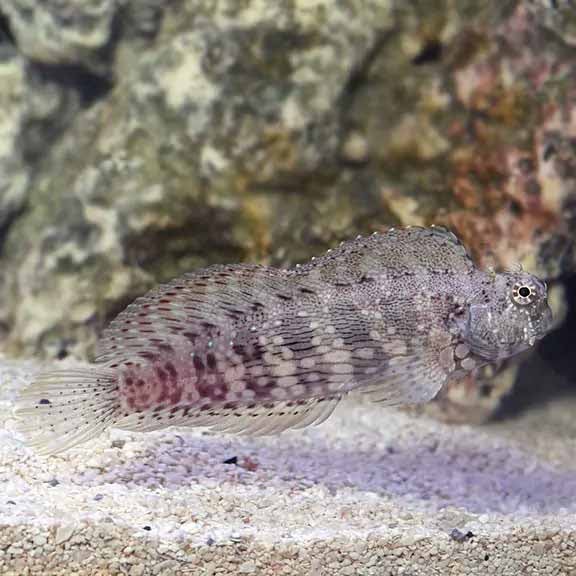
Lawnmower Blenny
The Lawnmower Blenny , also called Sailfin/Algae Blenny , Jewelled Rockskipper , or Rock Blenny , will help rid your aquarium of unsightly hair and string algae. The Lawnmower Blenny has a unique look and winning personality. With a mottled tan color, oversized eyes, elongated, scale-less body and large dorsal fin that extends the length of its body, the Lawnmower Blenny adds visual appeal to any marine aquarium.
The Lawnmower Blenny is funny and active, but peaceful, spending much of its time perched on corals or rocks or grazing on microalgae. The Lawnmower Blenny requires little care and little direct feeding, as they can often survive on what is found naturally in the tank, but they require a larger system with a variety of live rock and rockwork. A 30-gallon or larger tank with a tightly sealed lid is also recommended for this prolific jumper.
Native to the reefs across the Indo-Pacific, the Lawnmower Blenny does best in well-established aquariums with large amounts of natural algae to feed on. The diet can be supplemented with vegetable matter, spirulina, and herbivore preparations.
Approximate Size: Small: 1" to 1-1/2"; Medium: 1-1/2" to 2-1/2"; Large: 2-1/2" to 3-1/2"; X Large: 3-1/2" to 5"
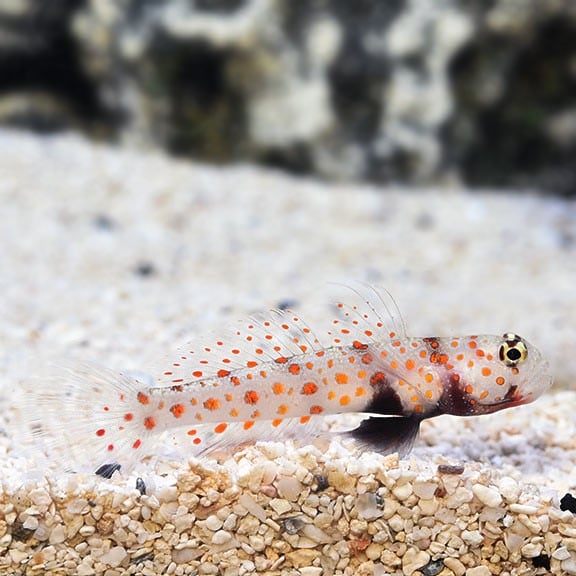
Orange Spot Goby
The Orange Spot Goby , also known as the Spotted Prawn Goby or Orange Spotted Shrimp Goby , was first discovered in the Western Pacific in 1938. Its body is white with orange spots outlined in brown. The Orange Spot Goby has the ability to form symbiotic partnerships with nearly blind alpheid shrimp, providing a watchful eye while the shrimp digs a burrow for them to share.
In the wild, Orange Spot Gobies inhabit sandy areas of lagoons and seaward reefs. They usually occur in pairs and excavate a shallow burrow from bits of rubble as a safe refuge.
The Orange Spot Goby is best suited for aquariums that are 10 gallons or larger with adequate hiding places and ample swimming space. The aquarium should have a tight-fitting lid to prevent the Orange Spot Goby from jumping out. The Orange Spot Goby adapts well to reef aquariums, although it does pose a possible threat to small, delicate ornamental shrimp. The Orange Spot Goby prefers a bed of fine sand and loose coral rubble to sift through. The sand is taken in through the mouth, the food items swallowed, and the remaining sand expelled through the gills, often dropping onto and swamping prized coral. For this reason, they are not always a welcome addition to aquaria containing delicate coral.
The Orange Goby's diet should consist of a variety of fresh or frozen mysis shrimp, vitamin-enriched brine shrimp, and table shrimp. It should be fed at least twice per day.
Approximate Size: 1" to 2"
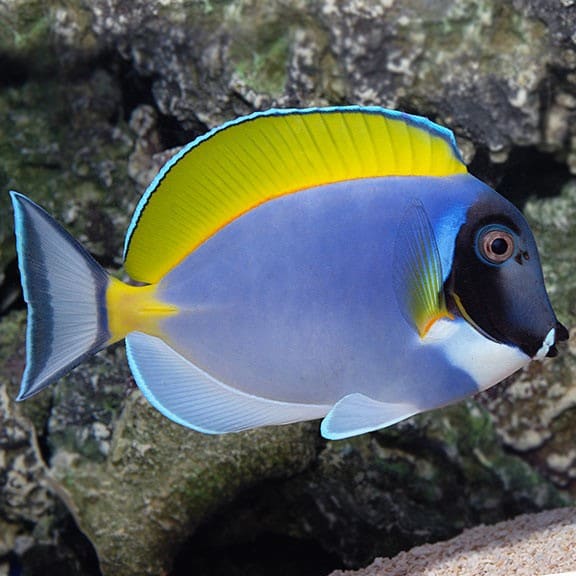
Powder Blue Tang
The Powder Blue Tang , also known as the Powder Blue Surgeonfish , has an oval body and extremely colorful, bold markings with several varying shades of blue accented by yellow and white. The face and tail are outlined with striking blue-black markings while the dorsal and pectoral fins are highlighted in bright yellow.
A 125-gallon or larger aquarium is necessary to provide plenty of swimming room. The Powder Blue Tang is extremely aggressive towards other Tangs or Surgeonfish, especially those similar in form and color, and should be the only one in the tank except in very large systems. It is best to introduce all at once if more than one is to be maintained in the same aquarium.
Although Tangs will eat meaty foods along with the other fish in the aquarium, it is important that they are offered plenty of marine based seaweed and algae to strengthen their immune system, reduce aggression and improve their overall health. Offer dried seaweed tied to a rock or use a veggie clip, and feed at least 3 times per week. Sea Veggies, Seaweed Salad and Ocean Nutrition are all ideal products and are very easy to use.
Approximate Size: Small: 1-1/2" to 2-1/2"; Small/Medium: 2-1/2" to 3"; Medium: 3" to 4"; Medium/Large 4" to 5"; Large: 5" to 6"
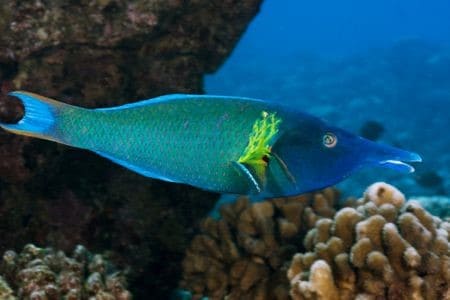
Bird Wrasse
The most unique aspect about the Bird Wrasse is its elongated beak which is used to catch long, skinny prey and hold it captive while breaking it up into bite-size pieces. The female is brownish black, and the male is variations of green. For this reason, the male is often called the Green Bird Wrasse , and the female, the Black or Brown Bird Wrasse .
The Bird Wrasse is a great fish for a beginner, as long as it is provided with a large enough tank. They are very hardy and disease resistant. A 125-gallon or larger aquarium with large amounts of live rock which furnish food and hiding places provides a good environment. They are very energetic fish and are always on the move. Because the Bird Wrasse is a "jumper," a tight-fitting lid on the tank is necessary. If a pair of Bird Wrasse are to be included in a tank, the female should be introduced first. The Bird Wrasse diet should include vitamin enriched frozen mysis shrimp, vitamin enriched frozen brine shrimp, and other meaty foods along with a high-quality marine flake and marine pellet food.
Approximate Size: Small: 2" to 3"; Medium: 3" to 4"; Large: 4" to 6" X Large: 6" to 7"
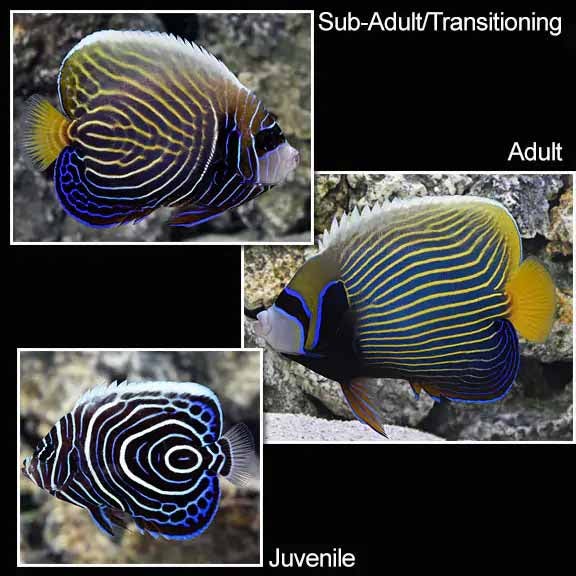
Emperor Angelfish
The adult Emperor Angelfish , also called the Imperator Angelfish, has a bold, blue body covered with bright yellow horizontal stripes ending in a bright yellow to orange tail fin. The eyes are covered in a striking blue-black mask and a similarly-colored vertical band extends from the pectoral fin two-thirds of the way up the body. This band is highlighted in sapphire-blue in front, and bright yellow, at the tail. The mouth is white.
The juvenile is black with circular white and blue stripes starting at the tail. In captivity, the adult coloration may not be as striking or brilliant. The changing angelfish will vary in coloration and pattern as it transforms from juvenile to the adult coloration.
The Emperor Angelfish requires a 220 gallon or larger tank with live rock for grazing and hiding. They also require extensive rock work and deep caves to feel secure. It will nip at stony and soft corals (sessile invertebrates) and clam mantles, but may be kept with small stony corals and somewhat noxious soft corals.
It should be fed a diet of Spirulina, marine algae, high-quality angelfish preparations, mysis or frozen shrimp, and other meaty items.
Approximate Size: Juvenile Small: 1" to 1 3/4"; Juvenile Medium: 1-3/4" to 2-1/2"; Juvenile Large: 2-1/2" to 3"; XLarge: 3" to 3-1/2"; Changing Small: 2" to 3"; Medium: 3" to 4" Large: 4" to 5" Adult Small: 2-1/2" to 3-1/2"; Adult Medium: 3-1/2" to 4-1/2"; Medium/Large: 4-1/2" to 5-1/4"; Adult Large: 5-1/4" to 6" XLarge: 6" to 7"; XXLarge: 7" to 9"; Show Size: 9" to 11"
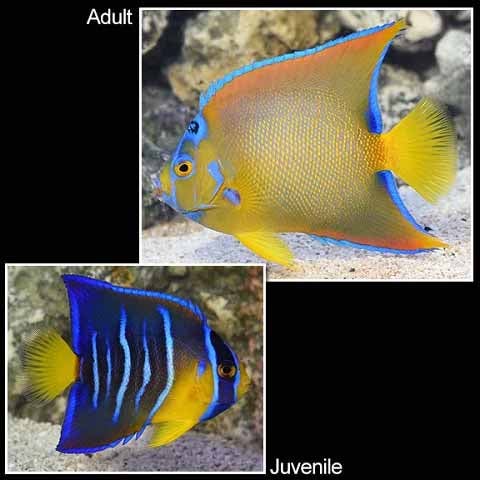
Queen Angelfish
The Queen Angelfish is one of the most iconic, brightly colored species on coral reefs of the Caribbean Sea and its adjacent waters. Vibrant yellow and electric sapphire-blue highlights give the Queen Angelfish an almost iridescent appearance. The Queen Angelfish gets its name from the coloration on its head that gives the impression that it is wearing a crown. The dorsal and pelvic fins are elongated.
The Queen Angelfish needs a large tank (minimum of 250 gallons), with lots of hiding places and live rock for grazing. Not a good reef dweller, the Queen Angelfish is prone to nip at stony and soft corals (sessile invertebrates) and clam mantles. It can be aggressive, so it must be introduced to the community tank last. A somewhat difficult angelfish to keep, Queen Angelfish often suffer from incorrect water parameters and diet.
The diet should include Spirulina, marine algae, high-quality angelfish preparations, mysis or frozen shrimp, and other meaty items. The Queen Angelfish should be fed at least three times daily.
The Small Juvenile will contain the Juvenile colorations or may be color shifting to a young adult, while the Medium will be a sub-adult, and the Large will be in Adult coloration.
Approximate Size: Juvenile Small: 1" to 1-1/2"; Medium: 1-1/2" to 2-1/4"; Large: 2-1/4" to 3-1/4"; Adult Small: 3" to 3-1/2"; Small/Medium: 3-1/2" to 4"; Medium: 4" to 4-1/2"; Medium/Large: 4-1/2" to 5"; Large: 5" to 6"; X Large: 6" to 7"
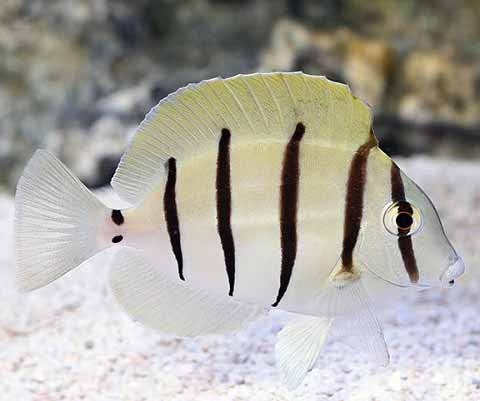
Convict Tang
The Convict Tang , also commonly referred as the Convict Surgeonfish, features a stunning white to silver body highlighted with six vertical black bars. The spines near the tail are small compared to that of other Tangs. The Convict Tang is a great addition to the reef or fish-only aquarium. It requires a large area in which to swim - at least a 125 gallon aquarium. It should not be included in a tank with other species of Tangs, since they will harass it. It will live peacefully with other Convict Tangs if all are introduced to the tank at the same time.
Convict Tangs have no distinguishing characteristics which will help differentiate males from females. They are very difficult to breed in the aquarium setting because they remain in the planktonic stage for months, and are in constant danger from filters.
Although Tangs will eat meaty foods along with the other fish in the aquarium, it is important that they are offered plenty of marine based seaweed and algae. This will strengthen their immune system, reduce aggression and improve their overall health. Offer dried seaweed tied to a rock or use a veggie clip, and feed at least 3 times per week. Sea Veggies, Seaweed Salad and Ocean Nutrition are all ideal products and are very easy to use.
Approximate Size: Tiny: 3/4" to 1-1/2"; Small: 1-1/2" to 2"; Small/Medium: 2" to 2-3/4"; Medium: 2-3/4" to 3-1/4"; Medium/Large: 3-1/4" to 4-1/4"; Large: 4-1/4" to 6-1/4"
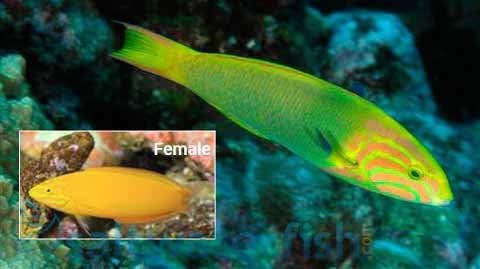
Sunset Wrasse
The Sunset Wrasse has a multitude of common names including the Banana Wrasse, Lime Green Wrasse, Lime Green Sunset Wrasse, Yellow-brown Wrasse, or Yellow Wrasse. It features unique green facial markings with yellow/brown/green striping across its body. As an adult, it takes on a yellow appearance if female, and a blue appearance if male. Both sexes have facial markings in green and fine vertical striping along the body. The fins are very colorfully marked.
Like other wrasse species, it is best kept in a tank with a tightly sealed lid to prevent escapes, plenty of live rock hiding places, and a sandy substrate. It should reside in a 125 gallon or larger aquarium, with other aggressive tank mates, such as Tangs, Puffers and small Triggers and Angels.
They are relatively reef safe species if paired with suitable tank mates. They will feed on a carnivorous diet consisting of small sessile inverts, crustaceans, and sometimes even diminutive fish. It may eat mantis shrimp and bristleworms. It does not eat corals or live plants.
The Sunset Wrasse diet should include vitamin enriched frozen mysis shrimp, vitamin enriched frozen brine shrimp, and other meaty foods along with a high quality marine flake and marine pellet food.
Approximate Size: Males: Small: 1-1/2" to 3"; Medium: 3" to 6"; Large: 6" to 10" Females: Small: 1-1/2" to 2"; Small/Medium: 2" to 3" Medium: 3" to 4"; Medium/Large: 4" to 5"; Large: 5" to 6"
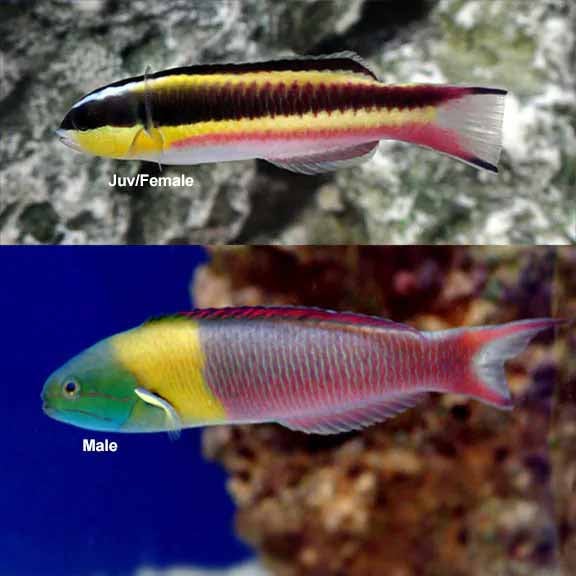
Paddlefin Wrasse
The Paddlefin Wrasse is also referred to as the Rainbow or Cortez Rainbow Wrasse. This wrasse is named not only for its native environment, the Sea of Cortez, but also for its bold rainbow coloring.
As a juvenile and initial phase female they feature a striped rainbow pattern of black, yellow and pink. As they mature into an adult, their coloration brightens into an array of colors. Their body takes on a reddish coloration, and the head area and fins become blue to green in color. Adding to the appeal of the adult fish, is a bright yellow band located just behind the head. These are one of the smaller Wrasse within the genus, and make a wonderful addition to a saltwater fish only aquarium.
The Paddlefin Wrasse is active, hardy, and long-lived in the aquarium. Though smaller than most of these wrasses it is still very active during the day and will need to have plenty of swimming room. It also will need a lot of rockwork with nooks and crannies for retreating as well as for sleeping at night. Juveniles will sometimes act as cleaners but become aggressive as adults. It is an excellent fish for the community aquarium as long as its tank mates are of a similar temperament. This wrasse doesn't bother corals but it will eat crustaceans, invertebrates, and small fish. It may even eat mantis shrimp and bristleworms.
The Paddlefin Wrasse diet should include vitamin enriched frozen mysis shrimp, vitamin enriched frozen brine shrimp, and other meaty foods along with a high-quality marine flake and marine pellet food.
Approximate Size: Small: 1-1/2" to 3"; Medium: 3" to 4"; Large: 4" to 6"





